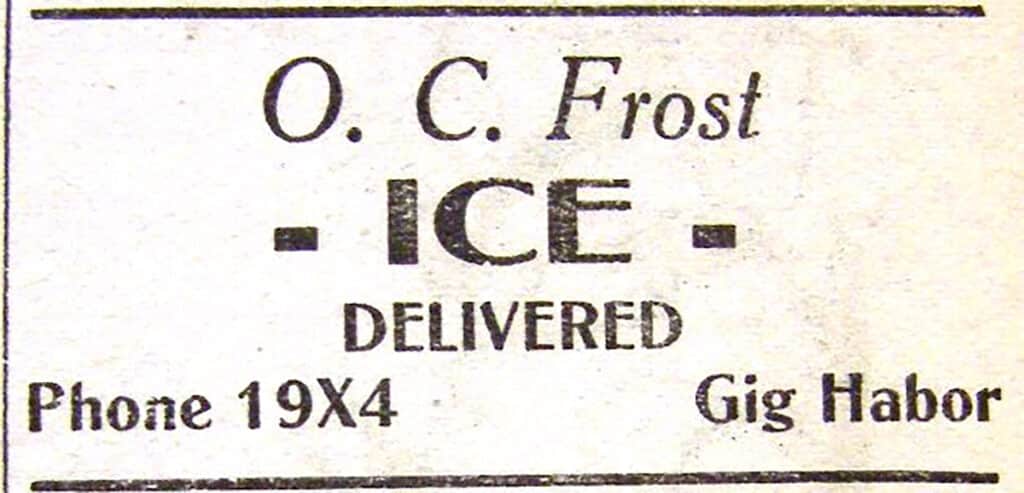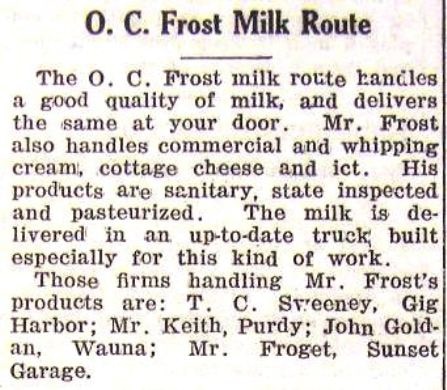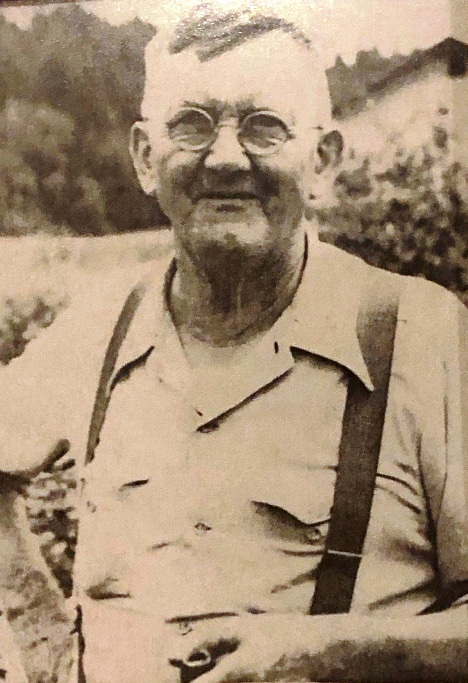Arts & Entertainment Community
Gig Harbor Now and Then | Cold, hard facts about ice delivery in 1931
Our previous column’s subject transitioned from a failure to deliver fire to the successful delivery of ice. The Gig Harbor Now and Then local history question was:
Community Sponsor
Community stories are made possible in part by Peninsula Light Co, a proud sponsor of Gig Harbor Now.
What was the name of the ice delivery man in Gig Harbor in 1931?
Answer: Let’s see, what are the most obvious possibilities? Ice, Icicle, Cold, Chill, Cool, McCool, Crushed, Cube, Frozen, Freezing, Fire, Heat, Fahrenheit, Frigid, Glacier, Hail, Melt, Slush, Sleet, Snow, Winter, Frost.
It was the last one. His name was Frost.
Oh, yes, it was.
Owen Charles Frost.
Ed Friedrich came up with a good one we didn’t think of, Flo. But that was Owen’s wife’s name … no, it wasn’t. Her name was Mabel. But Mabel was his first wife. His second wife’s name really was … Bernice. Yep, Burn-ice Frost.
It’s curious that Mr. Frost noted on his World War 1 draft registration card that he was missing a part of his right hand. Hmm … frostbite?
Anyway, in addition to delivering ice, Mr. Frost was also the local milkman, delivering a variety of dairy products door to door.
Unfortunately, no satisfaction will be realized this week for having the right answer, for the documentation has been disqualified. It’s entirely my fault, for I failed to prove that Mr. Frost delivered ice in Gig Harbor.

Owen Frost’s advertisement in the local newspaper specifically states his location as Gig Habor, not Gig Harbor. From the Harbor History Museum.
In fact, his newspaper ad of September 11, 1931, in The Peninsula Gateway, specifically states that he delivered in Gig Habor, not Gig Harbor. Seeing that and realizing my mistake, I was then hoping a short profile of Mr. Frost’s business that appeared in the August 7, 1931, issue of the same newspaper would prove he was also the local iceman for Gig Harbor, but it did not. While it says that he delivered milk, whipping cream, cottage cheese, and ict to Gig Harbor and vicinity, it does not mention ice.

Among other products, Owen Frost delivered ict on his milk route. From the Harbor History Museum.
I don’t know what ict is. Perhaps it’s a form of ice I’m not familiar with (whipped, maybe?), but without knowing for sure, I’m going to have to strike the question from the record. Questions are not valid if the answers cannot be documented.
Had I framed the question as “What was the name of the ict delivery man in Gig Harbor in 1931?” it would’ve passed muster. But I didn’t, so it doesn’t, and the disqualification stands. I will try to do better with this week’s question.
Recovering from failure
Having completely botched this week’s answer, the pressure is on to come up with a competent new question.
“Competent” may be a far cry from “excellent,” but when recovering from failure, “competent” is far more realistic. And a lot easier, too.
But wait a minute …
In an unexpected turn of events, this week’s question is better than good.
Ha! “Competent” can go pound sand! “Excellent” has arrived, just in time. And the answer’s not that tough, so it’s the best of both worlds.
This week’s question spans both the Gig Harbor and Key peninsulas. It’s a reminder that the good ol’ days weren’t always so good.
An accident waiting to happen
Previous generations on the Peninsula were subject to a variety of accidents that no one suffers today. Some of those accidents could ruin your day. Or week. Sometimes, even months.
All of the following people suffered identical accidents that aren’t experienced today. They happened throughout the year, so were not seasonal. The victims ranged from pre-teens to the elderly. Their injuries varied, but the cause was the same. Keep in mind that these are just a very few examples:
In 1921, Charles Green broke his arm, as did Harold Peterson of Purdy. Charlie Dieball nearly broke his arm. In the same year, Dan Yates of Rosedale injured his knee and back.
In 1924, both Chub Mort and Richard McQueen broke an arm.
Antone Peterson broke his arm in 1930.
In 1931, both Lester Heineman of Rosedale and Sivert Swenson of Purdy broke a wrist, and 75-year-old Abram S. Hall of Sagamore Farm in Gig Harbor “suffered a dislocation and fracture of the right radius and a compound dislocation of the right ulna.”

Sivert Swenson of Purdy broke his right wrist in 1931. Photo provided by his great-great-grandson, Joe Steiner.
In 1933, Everett Dahl of Vaughn broke both bones in his right forearm (the ulna and radius). He was treated at the Monzingo Hospital in Gig Harbor.
In 1936, 15-year-old Benny Alvestad of Crescent Valley broke his right arm. Dr. Denzler set the fracture.
In 1944, 12-year-old Raymond Stroup of Herron Road in Home broke his arm.
While all the victims in this list are men and boys, the type of accident was not confined to males. Women and girls suffered the same injuries, although in much smaller numbers.
And wouldn’t you know it, most often, those injuries happened just when you were about to go someplace.
What accident, happening during what activity, caused all those injuries?
Keeping in mind the range of years, the nature of the injuries is a major clue. Some good deductive reasoning can result in the right answer. And it’s already been documented, so there won’t be a repeat of this week’s unfortunate disqualification.
We’ll have the answer on March 11. In the meantime, take care of your radius and ulna.
Greg Spadoni of Olalla has had more access to local history than most life-long residents. During 25 years in road construction working for the Spadoni Brothers, his first cousins, twice removed, he traveled to every corner of the Gig Harbor and Key Peninsulas, taking note of many abandoned buildings, overgrown farms, and roads that no longer had a destination. Through his current association with the Harbor History Museum in Gig Harbor as the unofficial Chief (and only) Assistant to Linda McCowen, the Museum’s primary photo archive volunteer, he regularly studies the area’s largest collection of visual history. Combined with the print history available at the Museum and online, he has uncovered countless stories of long-forgotten local people and events.

